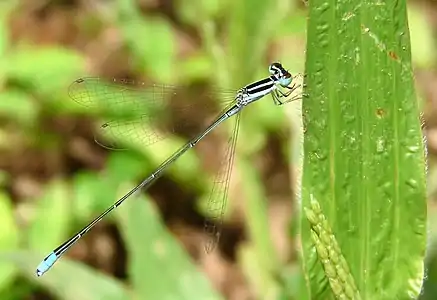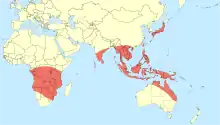| Aciagrion | |
|---|---|
 | |
| Aciagrion occidentale, male | |
 | |
| Aciagrion occidentale, female | |
| Scientific classification | |
| Domain: | Eukaryota |
| Kingdom: | Animalia |
| Phylum: | Arthropoda |
| Class: | Insecta |
| Order: | Odonata |
| Suborder: | Zygoptera |
| Family: | Coenagrionidae |
| Genus: | Aciagrion Selys, 1891[1] |
 | |
| Likely distribution of Aciagrion | |
Aciagrion is a genus of damselfly in the family Coenagrionidae.[2] Aciagrion are small and slender damselflies with a small head.[1] They are found at still waters including swamps. Aciagrion is widely distributed in the tropics from Africa, through Indonesia to Australia.[3] They are commonly known as Slims.
Species
The genus Aciagrion includes the following species:[4]
- Aciagrion africanum Martin, 1908
- Aciagrion approximans (Selys, 1876)
- Aciagrion azureum Fraser, 1922
- Aciagrion balachowskyi Legrand, 1982 - Gabon Slim[5]
- Aciagrion bapepe Dijkstra, 2015 - Congo Slim[6]
- Aciagrion borneense Ris, 1911
- Aciagrion brosseti Legrand, 1982 - Yellow-winged Slim[7]
- Aciagrion dondoense Dijkstra, 2007 - Opal Slim[8]
- Aciagrion fasciculare Lieftinck, 1934
- Aciagrion feuerborni Schmidt, 1934
- Aciagrion fragile (Tillyard, 1906) - Blue Slim[3]
- Aciagrion gracile (Sjöstedt, 1909) - Graceful Slim[9]
- Aciagrion hamoni Fraser, 1955
- Aciagrion heterostictum Fraser, 1955 - Long Slim[10]
- Aciagrion hisopa (Selys, 1876)
- Aciagrion huaanensis Xu, 2005
- Aciagrion macrootithenae Pinhey, 1972 - Awl-tipped Slim[11]
- Aciagrion migratum (Selys, 1876)
- Aciagrion nodosum (Pinhey, 1964) - Cryptic Slim[12]
- Aciagrion occidentale Laidlaw, 1919
- Aciagrion olympicum Laidlaw, 1919
- Aciagrion pallidum Selys, 1891
- Aciagrion pinheyi Samways, 2001 - Emerald-striped Slim[8]
- Aciagrion rarum (Longfield, 1947) - Tiny Slim[13]
- Aciagrion steeleae Kimmins, 1955 - Swamp Slim[14]
- Aciagrion tillyardi Laidlaw, 1919
- Aciagrion tonsillare Lieftinck, 1937
- Aciagrion walteri Carfi & D'Andrea, 1994
- Aciagrion zambiense Pinhey, 1972
References
Wikimedia Commons has media related to Aciagrion.
Wikispecies has information related to Aciagrion.
- 1 2 Selys-Longchamps, E. (1891). "Viaggio di Leonardo Fea in Birmania e regioni vicine XXXII". Annali del Museo Civico di Storia Naturale Genova. 2 (in French). 10: 433–518 [509] – via Biodiversity Heritage Library.
- ↑ "Genus Aciagrion Selys, 1891". Australian Faunal Directory. Australian Biological Resources Study. 2012. Retrieved 2 April 2017.
- 1 2 Theischinger, Günther; Hawking, John (2006). The Complete Field Guide to Dragonflies of Australia. Collingwood, Victoria, Australia: CSIRO Publishing. p. 290. ISBN 978 0 64309 073 6.
- ↑ Martin Schorr; Martin Lindeboom; Dennis Paulson. "World Odonata List". University of Puget Sound. Archived from the original on 28 August 2010. Retrieved 11 August 2010.
- ↑ Clausnitzer, V. (2018). "Aciagrion balachowskyi". IUCN Red List of Threatened Species. 2018: e.T184253A75302044. doi:10.2305/IUCN.UK.2018-1.RLTS.T184253A75302044.en.
- ↑ Clausnitzer, V. (2017). "Aciagrion bapepe". IUCN Red List of Threatened Species. 2017: e.T84379236A84382121. doi:10.2305/IUCN.UK.2017-3.RLTS.T84379236A84382121.en.
- ↑ Clausnitzer, V. (2017). "Aciagrion brosseti". IUCN Red List of Threatened Species. 2017: e.T184190A75302561. doi:10.2305/IUCN.UK.2017-3.RLTS.T184190A75302561.en.
- 1 2 Samways, Michael J. (2008). Dragonflies and Damselflies of South Africa. Pensoft. ISBN 954-642-330-0.
- ↑ Clausnitzer, V.; Dijkstra, K.-D.B. & Suhling, F. (2018). "Aciagrion gracile". IUCN Red List of Threatened Species. 2018: e.T59781A75303637. doi:10.2305/IUCN.UK.2018-1.RLTS.T59781A75303637.en.
- ↑ Clausnitzer, V. & Suhling, F. (2018) [amended version of 2016 assessment]. "Aciagrion heterostictum". IUCN Red List of Threatened Species. 2018: e.T59783A127507675. doi:10.2305/IUCN.UK.2018-1.RLTS.T59783A127507675.en. Retrieved 12 November 2021.
- ↑ Clausnitzer, V. & Suhling, F. (2018). "Aciagrion macrootithenae". IUCN Red List of Threatened Species. 2018: e.T63181A75305758. doi:10.2305/IUCN.UK.2018-1.RLTS.T63181A75305758.en.
- ↑ Clausnitzer, V. & Suhling, F. (2018). "Aciagrion nodosum". IUCN Red List of Threatened Species. 2018: e.T168009A75306252. doi:10.2305/IUCN.UK.2018-1.RLTS.T168009A75306252.en.
- ↑ Clausnitzer, V. & Suhling, F. (2018). "Aciagrion rarum". IUCN Red List of Threatened Species. 2018: e.T214A75306973. doi:10.2305/IUCN.UK.2018-1.RLTS.T214A75306973.en.
- ↑ Clausnitzer, V. & Suhling, F. (2017). "Aciagrion steeleae". IUCN Red List of Threatened Species. 2017: e.T59784A75307602. doi:10.2305/IUCN.UK.2017-3.RLTS.T59784A75307602.en.
This article is issued from Wikipedia. The text is licensed under Creative Commons - Attribution - Sharealike. Additional terms may apply for the media files.